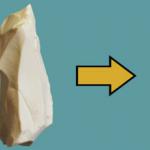Learning to Make a Stone Age Axe Gives Clues to How the Brain Evolved

For many decades, scientists have tried to understand the past by doing as our forebears did. One important endeavor in what is called experimental archaeology involves moderns crafting Stone Age tools by chipping away at rocks. Why toil at whittling rocks by hand using other rocks when machine tools are readily available?
One reason is to get at the question of what role toolmaking may have played in brain evolution, given the demands this task places on both mental faculties and motor skills. Toolmaking’s contribution to human evolution is controversial, though. Some theorists suggest that Paleolithic tool manufacture has little to with neural development, others hold that it is a driving force for our swollen frontal lobes.
The advent of the brain scanner has opened up the possibility of finding out who is right. I talked to Dietrich Stout, a professor of anthropology at Emory University about a recent paper in PLOS One that looked at the demands on brainpower that toolmaking placed on our Paleolithic ancestors from 500,000 to 2.6 million years ago.
1. Why is there a need to do experiments to link toolmaking to brain evolution?
Skulls (endocasts) provide important but limited evidence and can only tell us about whole brain size and shape, and maybe a little about surface features. If we are interested in how brain functions change over the course of evolution, we have to get at them indirectly through evidence of behavior, such as tool-making.
2. Describe your experiment reported recently in PLOS One.
We trained subjects for two years to make stone tools. It’s harder than you think! It can take hundreds of hours of dedicated practice to learn how to make a nice handaxe. It is even more difficult to figure out without some coaching.
Subjects in our studies actually did learn to make tools, though, and we also collected MRI scans at the beginning middle and end. In the scanner, we asked subjects to answer questions about tools we showed them—questions that dealt with decisions about how to shape a tool. By asking different questions, we distinguished basic perceptual-motor skill (understanding how rock breaks) from strategic planning abilities (choosing the right places to hit the rock to achieve a goal). We studied two different tool-making technologies – the simple Oldowan which is the earliest known technique from 2.6 million years ago and the more sophisticated Late Acheulean handaxe technology of about 500, 000 years ago. [Related story: "Archeologists Take Wrong Turn, Find World's Oldest Stone Tools"]
3. What did you find? Did it in some way provide hints of the evolution of higher mental functions?
We found that strategizing about how to make a tool was associated with activation of prefrontal cortex associated with the “executive” control of cognition—that is, holding information in mind while manipulating it. More specifically the pattern of activity suggested “mental time travel,” a complex cognitive ability to run mental simulations by projecting into the future or past. Think for example of planning out a home improvement project by mentally running through the steps and trying to identify problems before they happen. We found that this was necessary for the handaxe technology but not the earlier Oldowan, meaning that these artifacts can help us trace the timing and context for the emergence of this important human ability. It even suggests that the demands of learning to make stone tools may have been part of what drove the evolution of this capacity.
4. How important was toolmaking as a driver of evolution? Is it possible that it had something to do with the development of language?
Well, we don’t know for sure but our research has provided evidence suggesting it may have been quite an important driver. It’s not in this paper but my other publications have looked quite a bit at the link with language. There is increasingly strong evidence that an underlying mental ability to construct and understand complex, hierarchically structured sequences is important for both language and tool-making, so that selection on tool-making ability could have provided a “preadapted” base from which language later emerged.
5. Can you describe your Learning to Be Human Project (or the Language of Technology not sure which) project and what it’s trying to achieve?
This just-published study came from the Learning to be Human project, which is now over. The goal was to train modern subjects to make stone tools and observe all aspects of the learning process so we could better understand the challenges faced by our Paleolithic ancestors, and extract more information from the enigmatic stone artifacts that make up our “Stone Age” archaeological record.
Gary Stix, a senior editor, commissions, writes, and edits features, news articles and Web blogs for SCIENTIFIC AMERICAN. His area of coverage is neuroscience. He also has frequently been the issue or section editor for special issues or reports on topics ranging from nanotechnology to obesity. He has worked for more than 20 years at SCIENTIFIC AMERICAN, following three years as a science journalist at IEEE Spectrum, the flagship publication for the Institute of Electrical and Electronics Engineers. He has an undergraduate degree in journalism from New York University. With his wife, Miriam Lacob, he wrote a general primer on technology called Who Gives a Gigabyte? Follow on Twitter @@gstix1.
